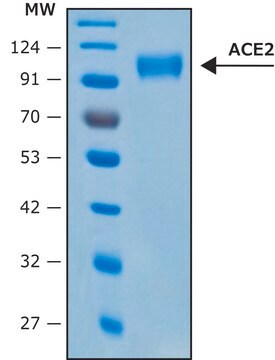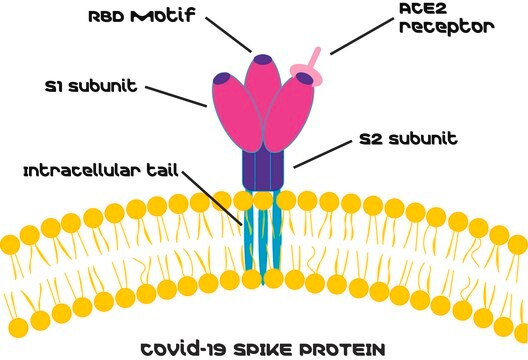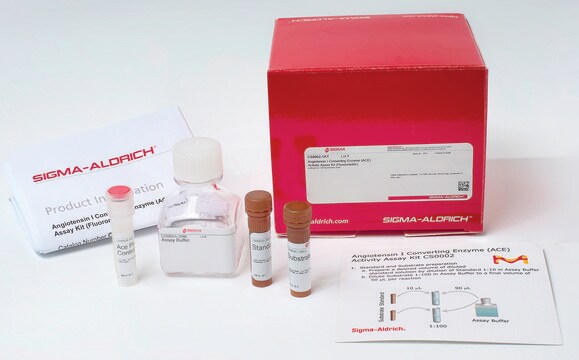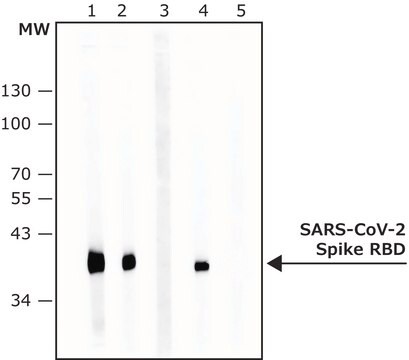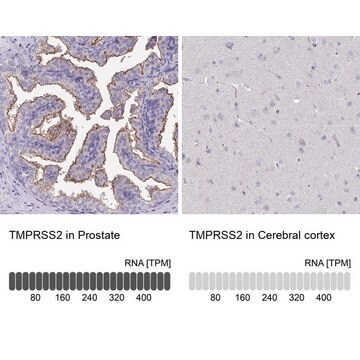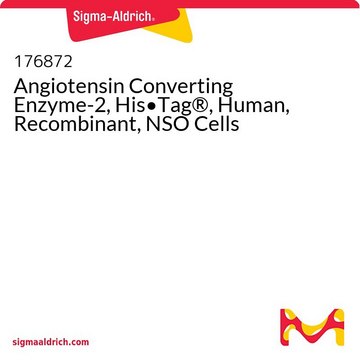SAE0171
Angiotensin Converting Enzyme-2, ACE2
biotin-tagged, human recombinant, ≥1000000U/mg, expressed in HEK 293 cells
Synonyme(s) :
ACE-related carboxypeptidase, ACE2, Angiotensin-converting enzyme homolog (ACEH), COVID-19 receptor, Metalloprotease MPROT15, SARS-COV2 receptor
About This Item
Produits recommandés
Produit recombinant
expressed in HEK 293 cells
Niveau de qualité
Description
Biotinylation: ≥90% (gel shift assay)
Essai
≥95% (SDS-PAGE)
Activité spécifique
≥1000000 U/mg
Conditions d'expédition
wet ice
Température de stockage
−20°C
Description générale
Coronaviruses such as SARS-CoV-2 and SARS-CoV-1 use the host ACE2 as a co-receptor to gain intracellular entry into the lungs and brain. The virion expresses a protein termed spike, which directly binds to the extracellular domain of ACE2. A specific region in the spike protein serves as the receptor binding domain (RBD). The ACE2:spike interaction has a high affinity of 15 nM.
Recombinant human ACE2 is expressed in human HEK 293 cells as a glycoprotein with a C-terminal FLAG® tag and his-tag with a calculated molecular mass of 85.9 kDa. The DTT-reduced protein migrates as a 90–120 kDa polypeptide on SDS-PAGE due to glycosylation.
This ACE2 is labelled with biotin, to form Angiotensin Converting Enzyme-2. This ACE2 biotin-tagged may serve as a useful tool for binding experiments while detecting protein: protein interaction assays using binding partners such as CoV spike protein. The degree of biotinylation is ≥90%. This ACE2-biotin can be visualized with streptavidin-conjugated probes (e.g., Streptavidin, HRP conjugate catalog No. 18-152).
Application
- Exploration of the protein protein interaction of ACE2 with is partners, like COV Spike protein.
- Tool for screening inhibitors for the interaction of ACE2 with COV Spike protein
Actions biochimiques/physiologiques
ACE2 is a new component of the renin-angiotensin system (RAS). It provides protective effects in peripheral tissues and has great potential for the treatment of RAS-related diseases.
Coronaviruses such as SARS-CoV-2 and SARS-CoV-1 use the host ACE2 as a coreceptor to gain intracellular entry into the lungs and brain. The virion expresses a protein termed spike, which directly binds to the extracellular domain of ACE2. A specific region in the spike protein serves as the receptor binding domain (RBD). The ACE2:spike interaction has a high affinity of 15 nM.
Caractéristiques et avantages
Définition de l'unité
Autres remarques
Informations légales
Code de la classe de stockage
11 - Combustible Solids
Classe de danger pour l'eau (WGK)
WGK 2
Faites votre choix parmi les versions les plus récentes :
Certificats d'analyse (COA)
It looks like we've run into a problem, but you can still download Certificates of Analysis from our Documents section.
Si vous avez besoin d'assistance, veuillez contacter Service Clients
Déjà en possession de ce produit ?
Retrouvez la documentation relative aux produits que vous avez récemment achetés dans la Bibliothèque de documents.
Notre équipe de scientifiques dispose d'une expérience dans tous les secteurs de la recherche, notamment en sciences de la vie, science des matériaux, synthèse chimique, chromatographie, analyse et dans de nombreux autres domaines..
Contacter notre Service technique